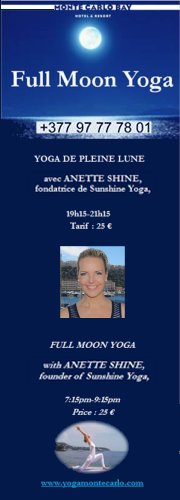Health and Beauty
Yoga Posture of the Month: SALAMBA SIRSASANA - Headstand
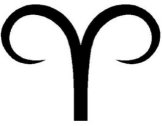
Aries
In Sanskrit Salamba means “supported” and Sirsa translates as “the head”, asana means “posture.”
This posture is also called “the king of the postures” due to its’ countless benefits, but mostly because of the beneficial pressure on the crown chakra (Sahasrara) which opens your spiritual horizons.
It is therefore considered one of the most important yogic postures.
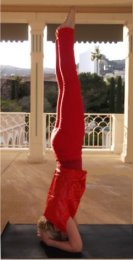
Headstands are effective postures that completely relate to the qualities of ARIES as they boost ones’ courage & self-confidence, sharpens ones’ memory and enhance clarity of thought.
Headstands also increase the concentration span as they bring a rejuvenating supply of blood to the brain cells.
Aries is ruled by the red planet Mars, which governs the head. Mars gives us will power & energy!
Props needed: A wall can be handy in the beginning, as you build up your self-confidence.
How to get started with headstands: I recommend that you start by learning how to do the basic “Tripod” pose so you get familiar with being inverted, but in a less challenging way:
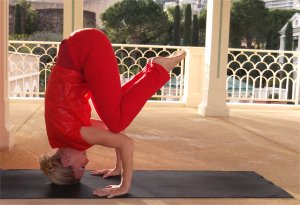
“Tripod pose” is also known as “The Clown” pose. With the right alignment most people can do it. It’s fun & feels “safer”, as one stays so close to the earth. (By the way: Children LOVE this pose!) The benefits of “Tripod” pose are almost identical to “Salamba Sirsasana”, as the pressure on the top of the head remains the same.
How to get into Tripod Pose:
Come down on your knees and place the crown of your head on the floor. Then place your hands flat, shoulder width apart so you can see your hands in front of you and your elbows are directly above your wrists. That way you form a triangle, which will set a solid foundation for the final pose. Keep your elbows shoulder width
apart as well, as they must be parallel and square. (A common mistake is to let them open out to the sides, and then you won’t be able to balance!) The next step is to straighten your legs off the ground, so you get the feeling of being inverted. Keep pressing the hands into the floor and most importantly keep holding your elbows in!
Walk your way up to a straight spine by keeping as little weight on your toes as possible.
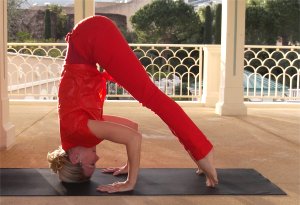
Important advice:
In order to do safe & solid balance poses it’s important to engage what we in sanskrit call “the bandhas” - “the internal locks”, which are:
“The navel lock” (uddiyana bandha) = The deep core muscles + “The root lock” (moola bandha) = The pelvic floor muscles.
Once we engage these locks we become light and in control of ourselves. We feel our inner strength & power and can master the more advanced poses, such as Salamba Sirsasana.
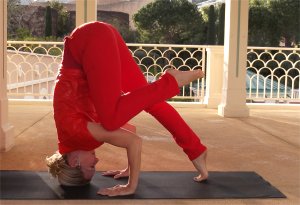
The final steps are to take one leg off the floor at a time: Begin by placing one knee up on your upper arm, (close to the elbow), take your time, then the second knee (remember to focus on your bandhas!) In the final pose the big toes will be touching and you can stay as long as it’s fun!
How to come out of ANY headstand:
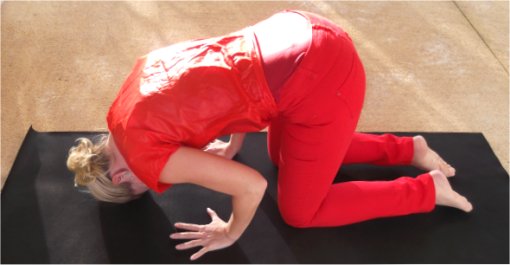
Come down slowly and keep your head down (do not sit up fast as the blood in the brain needs time to adjust right after!)
Come down and rest on your heals in “Childs pose” (Balasana) to recover and allow the effects of the headstand to settle in...
You can either have your arms by your sides, or in front, OR form fists with your hands and place one on top of the other under your forehead so the head is raised a bit off the floor which makes it easier to breathe. Pressure on “ajna”, the 6th chakra, (our 3rd eye) also stimulates the intuition.
Other benefits of headstands:
They build stamina, alleviate insomnia, strengthen the lungs, improve the function of the pituitary and pineal glands, relieve the symptoms of colds, coughs and tonsilitis, improves the circulation in the legs and all the internal organs...
Cautions:
Do not practice headstands if you have high blood pressure, cardiac conditions, a backache, migraine or headache.
Do not start any yoga practice with a headstand if you have low blood pressure. Do not attempt to do a full headstand (Salamba Sirsasana) on your own if you are a beginner! Inversions are not recommended during menstruation.
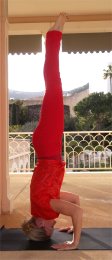
As you get stronger in “Tripod” you can take your mat to the wall and instead of having the knees bent on your arms you can straigthen them up in the air, squeezing your ankles together for better balance. This is another variation of a headstand “Salamba Sirsasana”...

Contact Anette Shine for any help you may need: sunshine@yogamontecarlo.com
or visit website.
Publicity by Anna Fill: anna@therivierawoman.com

